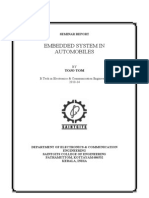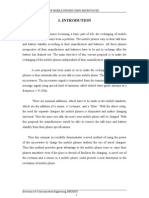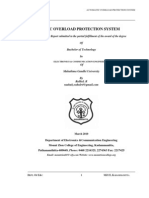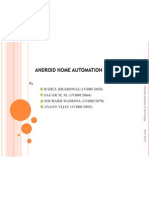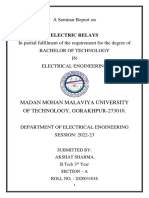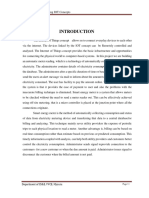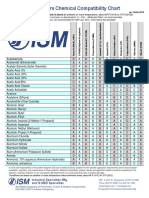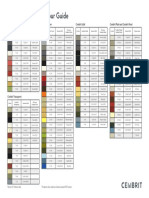Project Report of Smart Energymeter Using Iot
Uploaded by
Lukkuman AProject Report of Smart Energymeter Using Iot
Uploaded by
Lukkuman ASMART ENERGY METER USING IOT
CHAPTER 1
INTRODUCTION
1.1 GENERAL BACKGROUND
Electricity is an important invention without which life on Earth is impossible. So obviously
there is a need for measuring the consumed electricity. It is accomplished by the wattmeter,
but a person from KSEB has to visit each house for measuring the power consumption and
for calculating the bill amount.
So it requires much of manual work and consumes time. In order to avoid all these
drawbacks we have intended to construct an IoT based energy meter. So the proposed
energy meter measures the amount of power consumed and uploads it to cloud, from which
the concerned person can view the reading. The power reading is sent to cloud using
ESP8266, a Wi-Fi module. The power reading from Analog wattmeter is read using the
optocoupler and transmitted digitally with the ESP8266. So it automates the process of
measuring the power consumption at homes using IoT and thereby enabling remote access
and digitalization.
1.2 OBJECTIVES
Today the world is facing such an environment that offers challenges. Energy crisis is the main
problem faced by our society. A relevant system to control and monitor the power usage is one
of the solutions for this problem. One approach through which today‟s energy crisis can be
addressed is through the reduction of power usage in households. , a person from the Electricity
board should visit each and every house to note down the power reading and to calculate the bill
amount.
To carry out this procedure at least a person should be available in each of
their respective houses when the person from the electricity board arrives. So the consumers
cannot engage themselves in their private work according to their needs, because the time at
which the person arrives from the Electricity board is unknown. Moreover it does not provide
privacy as an unknown person enters into our house for power reading and calculation. This
MCE CHIRAYINKEEZHU, DEPT OF EEE Page 1
SMART ENERGY METER USING IOT
project is designed in such a way to overcome all the above hindrances caused by the former
mechanisms of measuring power.
1.3 SCHEME
Here the power reading is uploaded to cloud using ESP 8266. It is an UART (Universal
Asynchronous Receiver/Transmitter) to Wi-Fi module which allows microcontrollers to
connect to a Wi-Fi and make simple TCP/IP connections using AT commands. ESP 8266 is
an impressive, low cost Wi-Fi module suitable for adding Wi- Fi functionality to an existing
microcontroller. It is one of the leading platforms for IoT (Internet of Things).
As there is no human involvement in the entire process, there is no chance of
manual errors. These put more control into the hands of customers by giving them more
detailed information about power consumption.
MCE CHIRAYINKEEZHU, DEPT OF EEE Page 2
SMART ENERGY METER USING IOT
CHAPTER 2
LITERATURE SURVEY
For Communication to the server many options are there as wireless or wired such as cable
networks, and the different GSM modules, which is known researchers. Different Countries
Trying to implement this idea. From the different papers we have different researcher work
regarding our new concept.In paper [1] (2014) Pradip Kulkarni and Manisha Shinde has publish
a paper on automation of electricity billing process in that new architecture that the electricity
board has manual process and to remove that process they introduced a module in which data is
gather from the energy, water and devices and transfer to the centralized station from the billing
purpose.
The data is collected using single camera, with means the camera is placed in front of
the meter of the everyone‟s house and the camera will capture image of meter and server will
directly fetch that data from the each house, so that human interaction is totally avoided. ARM7-
LPC 2138 is used as the interface between the devices. After that the image will reach to server
and undergoes the different processing through Mat lab, so that the every month reading is stored
in the database of the electricity board.
So the technology used in this paper was image segmentation and the AMR, zigbee, so
that advantages of this technology was this technology is used properly, and the disadvantages
for this architecture was that it is costly. In paper[2](2015) R.G.Yadawad has publish on
intelligent electricity billing and the maintenance system in which new way of billing process
there was many errors in the different models which were introduced earlier so in this paper the
model used was through mobile agents.
This Paper tells us about the how the new architecture is more feasible using mobile
agents. The proposed model of this model consists of the server, digital meter, and smartcard,
software agents, PLCC and directly sync with the bank account. The server is used as a central
entity which supports overall activities of the system. The main works of the server is to
maintain the central database of the electric board with includes the user information and their
smart cards information. Bank account is directly sync in the database to the user account.
MCE CHIRAYINKEEZHU, DEPT OF EEE Page 3
SMART ENERGY METER USING IOT
Digital meter is installed to the users‟ house as it will work as an embedded system that Is consist
of the processor, which will work such as user functionalities, communication with the servers
and the power supply. Smart cards are provided by the electric board and the smart card contains
1.unique Identification number and Bank Information.
Software agents they have capabilities of the creating better client-server
architecture, here the mobile agents gives that information but they are not good for the data
transfer. FTP is used for the data transfer over the internet. Power line carrier communication
does the work of transmit the data over the power lines; it is a deepest capillarity in the world
since the power lines introduced. It operates the radio frequencies generally below 600 KHz
transmit over the lines. Sync with the bank account the server maintains the record of the billing
process so that bill amounts are automatically deducted from the user account.
Or in another way user may also pay by cash or the mobile phones. The technology
used in this model is IOT, and the advantage by using this architecture is the mobile networks
and the fast way for processing of the bill, and as mobile networks are using it requires more
mobile towers to communicate which will also increase the cost this is disadvantage of the this
model. In paper [3] (2014) Nidhi Gaur has publish on Prepaid electricity Billing Machine using
FPGA, this paper shows the advancement of the technology.
This paper includes PEBM Design implementation with description, Flow chat
and FSM. How the results are on the Xilinx Spartan6 FPGA Device is explained, it also
explained the design specification over Power Supply, total current, logic utilization and the
memory and timing information.
MCE CHIRAYINKEEZHU, DEPT OF EEE Page 4
SMART ENERGY METER USING IOT
CHAPTER 3
COMPARISON BETWEEN EXISTING AND PROPOSED
SYSTEM
3.1 EXISTING METHOD-
The present system only provides feedback to the customer at the end of the month. Also the
meter readings are taken manually. Consumer can know the units consumed by seeing their
electricity bill only. Also huge manpower is required to take the readings. There is no protection
for energy meter tampering. The consumers cannot monitor the everyday energy consumption or
usage. The major drawback of this system is the management of power consumption is difficult.
The conventional mechanical energy meter is based on the phenomenon of “Magnetic
Induction”. It has a rotating Aluminium Wheel called Ferriwheel and many toothed wheels.
Based on the flow of current, the Ferriwheel rotates which makes rotation of other wheels. This
will be converted into corresponding measurements in the display section. Since many
mechanical parts are involved, mechanical defects and breakdown are common.
The Electricity Board have got used to the manual process and they go along with it even though
there are many concerns coupled with it. Because of the human errors after getting faulty bill, it
is problem of user to get it corrected from the energy supply board. In that case customer has to
stopover the office, stand in a queue and get it corrected. The problem is just because of human
intervention.
3.2 PROPOSED METHOD-
In the proposed method, the consumer can manage their energy consumption by knowing their
energy usage time to time. This method not only provides two way communications between
utility and consumer but also provides other functions that are if the consumer fails to pay the
electricity bill the energy supply would be cut down from the utility side and once the bill is paid
the energy supply is reconnected. Another huge advantage of this system is that it notifies the
consumer & utility at the event of the meter tampering. By this information the consumer &
utility can control the tampering are reduce energy crises.
Since IoT is cost effective compared to SMS, monitoring of energy meters at lower cost is made
possible. Daily consumption reports are generated which can be monitored through web portal.
The current system of electrical energy billing is erroneous and also time consuming. Errors
MCE CHIRAYINKEEZHU, DEPT OF EEE Page 5
SMART ENERGY METER USING IOT
introduced at every stage are due to electro -mechanical meters, human errors while noting down
the meter reading. This Project reduces the deployment of manpower for taking meter readings.
It has many advantages from both suppliers as well as consumer‟s point.
Smart Meter Reading. A device which remotely obtain meter readings and transmits this data to
the system‟s computer via communication media such as IOT(Internet communication module)
This devices can detect outages, remotely connect and disconnect services, detects tampering as
well as other uses. Economic benefits include increased cash flow, lower Labour and equipment
cost, increased accuracy and lower costs. Some customer satisfaction benefits include improved
service quality, more customer choices and faster response time
MCE CHIRAYINKEEZHU, DEPT OF EEE Page 6
SMART ENERGY METER USING IOT
CHAPTER 4
METHEDOLOGY
Fig 4.1: Block Diagram Representation of IoT Based Smart Energy Meter
MCE CHIRAYINKEEZHU, DEPT OF EEE Page 7
SMART ENERGY METER USING IOT
4.1 ENERGY METER:
Energy meter or watt-hour meter is an electrical instrument that measures the amount of
electrical energy used by the consumers. Utilities is one of the electrical departments, which
install these instruments at every place like homes, industries, organizations, commercial
buildings to charge for the electricity consumption by loads such as lights, fans, refrigerators and
other home appliances. Energy meter measures the rapid voltage and currents, calculate their
product and give instantaneous power. This power is integrated over a time interval, which gives
the energy utilized over that time period.
This high quality, single phase electronic watt-hour meter features LSI and SMT technology to
offer reliable operation in strict scientific aging test, debugging process and management
methods with sustained accuracy. It is used to measure and monitor electrical energy in single
phase environments such as in both indoor and outdoor. Tamper proof meter has magnetic
shielding to provide optimum resistance to surge and provides LED indication for current
reversal tampering as well as phase availability. Low power consuming meter comes with flame
retardant, durable polycarbonate enclosure that provides high resistance to UV and high impact.
Fig 4.2 Single Phase Electronic Watt-hour Meter
MCE CHIRAYINKEEZHU, DEPT OF EEE Page 8
SMART ENERGY METER USING IOT
4.2 Wi-Fi MODULE (ESP8266):
Fig 4.2 ESP8266 Microcontroller.
The ESP8266 is a very user friendly and low cost device to provide internet connectivity to your
projects. The module can work both as a Access point (can create hotspot) and as a station (can
connect to Wi-Fi), hence it can easily fetch data and upload it to the internet making Internet of
Things as easy as possible.
It can also fetch data from internet using API‟s hence The project could access any
information that is available in the internet, thus making it smarter. Another exciting feature of
this module is that it can be programmed using the Arduino IDE which makes it a lot more user
friendly.
MCE CHIRAYINKEEZHU, DEPT OF EEE Page 9
SMART ENERGY METER USING IOT
4.2.1 ESP8266-01 Features-
Low cost, compact and powerful Wi-Fi Module
Power Supply: +3.3V only
Current Consumption: 100mA
I/O Voltage: 3.6V (max)
I/O source current: 12mA (max)
Built-in low power 32-bit MCU @ 80MHz
512kB Flash Memory
Can be used as Station or Access Point or both combined
Supports Deep sleep (<10uA)
Supports serial communication hence compatible with many development platform like
Arduino
Can be programmed using Arduino IDE or AT-commands or Lua Script.
4.2.2 Applications of ESP8266-
IOT Projects
Access Point Portals
Wireless Data logging
Smart Home Automation
Learn basics of networking
Portable Electronics
Smart bulbs and Sockets
MCE CHIRAYINKEEZHU, DEPT OF EEE Page 10
SMART ENERGY METER USING IOT
4.2.3 ESP8266 Pin Configuration
Pin Pin Name Alternate Normally used for Alternate
Number Name purpose
1 Ground - Connected to the ground of the circuit -
2 TX GPIO – 1 Connected to Rx pin of programmer/uC to Can act as a
upload program General
purpose
Input/output
pin when not
used as TX
3 GPIO-2 - General purpose Input/output pin -
4 CH_EN - Chip Enable – Active high -
5 GPIO - 0 Flash General purpose Input/output pin Takes module
into serial
programming
when held low
during start up
6 Reset - Resets the module -
7 RX GPIO - 3 General purpose Input/output pin Can act as a
General
purpose
Input/output
pin when not
used as RX
8 Vcc - Connect to +3.3V only
MCE CHIRAYINKEEZHU, DEPT OF EEE Page 11
SMART ENERGY METER USING IOT
NodeMCU Dev Kit v1.0(V2) Pinouts
MCE CHIRAYINKEEZHU, DEPT OF EEE Page 12
SMART ENERGY METER USING IOT
NodeMCU Dev Kit v1.0 pin descriptions
GPIO (General Purpose Input Output) Pins:
NodeMCU has general purpose input output pins on its board as shown in above pinout
diagram. We can make it digital high/low and control things like LED or switch on it.
Also, we can generate PWM signal on these GPIO pins.
ADC (Analog to Digital Converter) channel (A0):
NodeMCU has one ADC channel/pin on its board.
SPI (Serial Peripheral Interface) Pins:
NodeMCU based ESP8266 has Hardware SPI (HSPI) with four pins available for SPI
communication. It also has SPI pins for Quad-SPI communication. With this SPI
interface, we can connect any SPI enabled device with NodeMCU and make
communication possible with it.
I2C (Inter-Integrated Circuit) Pins:
NodeMCU has I2C functionality support on ESP8266 GPIO pins. Due to internal
functionality on ESP-12E we cannot use all its GPIOs for I2C functionality. So, do tests
before using any GPIO for I2C applications.
UART (Universal Asynchronous Receiver Transmitter) Pins:
NodeMCU based ESP8266 has two UART interfaces, UART0 and UART1. Since
UART0 (RXD0 & TXD0) is used to upload firmware/codes to board, we can‟t use them
in applications while uploading firmware/codes.
MCE CHIRAYINKEEZHU, DEPT OF EEE Page 13
SMART ENERGY METER USING IOT
4.3 WEBPAGE (HTML): We designed webpage for operating Arduino and Energy Meter with
the help of HTML. HTML stands for Hypertext Markup Language. It is a standard markup
language for creating web pages and web applications with Cascading Style Sheets (CSS) and
JAVA scripts it forms a triad of cornerstone technologies for World Wide Web. Web browser
receives HTML documents from a Webserver or from local storage and renders them into
multimedia web pages.
HTML describes the structure of web page semantically and originally included cues for the
appearance of the document. HTML elements are the building blocks of HTML pages.
4.4 ThingSpeak with Smart Energy Meter
Signing up for ThingSpeak and connecting esp8266 Wi-Fi module with Wi-Fi.
Sending meter readings to ThingSpeak.
4.5 LCD DISPLAY
LCD (liquid crystal display) is the technology used for displays in notebook and other smaller
computers. Like light-emitting diode (LED) and gas-plasma technologies, LCDs allow displays
to be much thinner than cathode ray tube (CRT) technology. LCDs consume much less power
than LED and gas-display displays because they work on the principle of blocking light rather
than emitting it.
An LCD is made with either a passive matrix or an active matrix display display grid. The active
matrix LCD is also known as a thin film transistor (TFT) display. The passive matrix LCD has a
grid of conductors with pixels located at each intersection in the grid.
A current is sent across two conductors on the grid to control the light for any pixel. An
active matrix has a transistor located at each pixel intersection, requiring less current to control
the luminance of a pixel. For this reason, the current in an active matrix display can be switched
on and off more frequently, improving the screen refresh time (your mouse will appear to move
more smoothly across the screen, for example).
MCE CHIRAYINKEEZHU, DEPT OF EEE Page 14
SMART ENERGY METER USING IOT
Some passive matrix LCD's have dual scanning, meaning that they scan the grid twice with
current in the same time that it took for one scan in the original technology. However, active
matrix is still a superior technology.
The LCD only displays a text output however this is a user interface for display information
about battery power or distance to an object.
The nominal operating voltage for LED backlights is 5V at full brightness, with dimming at
lower voltages dependent on the details such as LED color. Non-LED backlights often require
higher voltages.
Fig 4.5 LCD Display
MCE CHIRAYINKEEZHU, DEPT OF EEE Page 15
SMART ENERGY METER USING IOT
CHAPTER 5
WORKING
Here we have interfaced electricity energy meter with ESP8266 using the pulse LED
(Calibration or Cal) of electricity Energy meter. The pulse LED can connect to ESP8266 through
an Optocoupler IC.
When we power up the system microcontroller reads the how many times pulse LED will blink
in a minute using following equation.
Pulse= (Pulse rate*watt*time)/ (1000*3600)
Then we need to calculate Power factor of a single pulse, means how much electricity will be
consumed in one pulse:
Power Factor=watt/(hour*pulse)
Using this power factor, we can calculate the no of units consumed by devices and then generate
bill. Generated bill can be send to the customer server account and to the electricity board
through wifi module. These data can also send to the LCD display connected to the ESP8266.
MCE CHIRAYINKEEZHU, DEPT OF EEE Page 16
SMART ENERGY METER USING IOT
CHAPTER 6
ARCHITECHURAL MODEL
Figure4.1: Architectural Diagram
1. When the various appliances of the household consume energy the energy meter reads
the reading continuously and this consumed load can be seen on meter.
2. We can see that the LED on meter continuously blinks which counts the meter reading.
Based on
3. The blinking, the units are counted. Normally, 3200 blinks is one unit.
MCE CHIRAYINKEEZHU, DEPT OF EEE Page 17
SMART ENERGY METER USING IOT
4. In our project we are trying to develop, a system in which ESP8266 act as main
controller, which continuously monitor energy meter.
5. As per the blinking of LED on energy meter the ESP8266 will measure the unit
consumption.
6. The measured reading with the calculation of the cost will be continuously displayed on
web page that we have designed.
7. Threshold value can be set on webpage with the help of Wi-Fi, as per the consumer‟s
requirement. When the consumers reading will be near about to the set threshold value it
will send a notification value to the consumer.
8. This threshold value notification will increase the awareness amongst the consumer about
the energy.
9. When the consumer gets the notification he can visit the webpage and change the
threshold value.
10. If the consumer is not aware with the threshold notification, then the meter will
automatically get off. Then the consumer has to visit the webpage again and increment
the threshold value. By the incrementation, the meter will automatically get ON.
11. Finally the overall monthly bill with cost will be sent to customer as well as service
provider in the form of text at first day of every month.
MCE CHIRAYINKEEZHU, DEPT OF EEE Page 18
SMART ENERGY METER USING IOT
CHAPTER 5
EQUATIONS AND MATHEMATICAL CALCULATION
Our system does not contain very vast and difficult calculations .Usually different meters have
different readings .Some have,
1500 blinks = 1 unit
Mostly, 3200 blinks = 1 unit depends on manufacturer.
In our case 3200 blinks of LED is 1 unit. But for practical purpose ,Assumption we made in our
system,
5 blinks = 1 unit of power consumption
Let, X = number of blinks of LED
Y = number of units of electricity
Z = cost of consumption
Basically,
No. of units (Y) = (X/3200)
But in our case,
Y = (X/5)
Assume that 1 unit cost = 5rs
Z = Y * 5rs
For Threshold,
Assumed threshold set value will be = 5 units for practical.
If units reach,
MCE CHIRAYINKEEZHU, DEPT OF EEE Page 19
SMART ENERGY METER USING IOT
Threshold value– 1 unit = 5-1 = 4 units,
Notification will be send to consumer, if consumer doesn‟t react and increase the threshold value
then meter will automatically get OFF.
Again to turn it ON consumer has to visit webpage again to increase threshold value.
UNIT:
Normally, basic unit of electricity is Kilowatt -hour (KWh).
1kWh = 1000 watt for 1 hour.
Example,
Ten 100watt bulbs used for 1 hour gives 1kWh
MCE CHIRAYINKEEZHU, DEPT OF EEE Page 20
SMART ENERGY METER USING IOT
CHAPTER 6
SOFTWARE SIDE PROGRAM
#include <ESP8266WiFi.h>
#include <WiFiClient.h>
#include <ThingSpeak.h>
#include <LiquidCrystal_I2C.h>
#include <EEPROM.h>
int addr = 10;
int called = 14;
int Switch=12;
float unit;
float value3;
float value1;
float value2;
int val1;
int val2;
int val4;
float val3;
float prevunit;
int cost = 3;
float bill;
int count=0;
int lcdColumns = 16;
int lcdRows = 2;
LiquidCrystal_I2C lcd(0x27, lcdColumns, lcdRows);
const char* ssid = "iot"; //Your Network SSID
const char* password = "123456789"; //Your Network Password
MCE CHIRAYINKEEZHU, DEPT OF EEE Page 21
SMART ENERGY METER USING IOT
WiFiClient client;
unsigned long myChannelNumber =781196; //Your Channel Number (Without Brackets)
const char * myWriteAPIKey = "9EZVO1M29DH2GGMX"; //Your Write API Key
void setup()
{
pinMode(Switch,INPUT);
pinMode(called,OUTPUT);
Serial.begin(9600);
EEPROM.begin(512);
WiFi.begin(ssid, password);
ThingSpeak.begin(client);
lcd.init();
lcd.backlight();
lcd.setCursor(4, 0);
lcd.print("IoT Smart");
lcd.setCursor(1, 4);
lcd.print("Energy Meter");
delay(1000);
lcd.clear();
void loop()
{ value3 = EEPROM.read(addr);
value1 = EEPROM.read(addr+1);
value2=value3+(value1/1000);
Serial.println(value2);
MCE CHIRAYINKEEZHU, DEPT OF EEE Page 22
SMART ENERGY METER USING IOT
if(digitalRead(called)==LOW)
{
count++;
}
if (count==10)
{ unit=count/3200;
count=0;
val3=unit+value2;
val4=val3*1000;
val1=val4/1000;
val2=val4%1000;
EEPROM.write(addr, val1);
EEPROM.write(addr+1, val2);
EEPROM.commit();
}
bill=(value2-prevunit)*cost;
Serial.println(bill);
lcd.setCursor(0, 0);
lcd.print("Unit = ");
delay(1000);
lcd.setCursor(10, 0);
lcd.print(value2);
delay(1000);
lcd.setCursor(0, 1);
lcd.print("bill = ");
delay(1000);
lcd.setCursor(10, 1);
lcd.print(bill);
if(digitalRead(Switch)==HIGH)
{
MCE CHIRAYINKEEZHU, DEPT OF EEE Page 23
SMART ENERGY METER USING IOT
ThingSpeak.writeField(myChannelNumber, 1,value2, myWriteAPIKey);
delay(11000);
ThingSpeak.writeField(myChannelNumber, 2,bill, myWriteAPIKey);
delay(11000);
prevunit=value2;
ThingSpeak.writeField(myChannelNumber, 3,"3", myWriteAPIKey);
delay(11000);
}
MCE CHIRAYINKEEZHU, DEPT OF EEE Page 24
SMART ENERGY METER USING IOT
CHAPTER 7
ADVANTAGES AND DISADVANTAGES OF SMART ENERGY METER
7.1 ADVANTAGES OF SMART ENERGY METER
1. Eliminate manual meter reading.
2. Makes it possible to use power resources more efficiently.
3. Provides real time data.
4. Enables dynamic pricing (raising or lowering the cost of electricity based on demand).
5. Quick monitoring of electrical systems.
7.2 DISADVANTAGES OF SMART ENERGY METER
1. Managing public reaction and customer acceptance.
2. Managing and storing vast quantities of metering data.
3. Ensuring security of metering data.
4. Transitioning to new technology is difficult.
5. Customers have to pay additional fees for the ne meter.
MCE CHIRAYINKEEZHU, DEPT OF EEE Page 25
SMART ENERGY METER USING IOT
CHAPTER 8
CONCLUSIONS
An attempt has been made to make a practical model of „IoT‟ Based Smart Energy Meter.‟ The
propagated model is used to calculate the energy consumption of the household, and even make
the energy unit reading to be handy.
Hence it reduces the wastage of energy and bring awareness among all. Even it will deduct
the manual intervention. Monitoring and keeping tracking of your electricity consumption for
verification is a tedious task today.
Since you need to go to meter reading room and take down readings. Well it is important to
know if you are charged accordingly so the need is quite certain. Well we automate the system
by allowing users to monitor energy meter readings over the internet.
The meter is used to monitor units consumed and transmit the units as well as cost charged
over the internet using wifi connection. This allows user to easily check the energy usage along
with the cost charged online using a simple web application. Thus the energy meter monitoring
system allows user to effectively monitor electricity meter readings and check the billing online
with ease.
MCE CHIRAYINKEEZHU, DEPT OF EEE Page 26
SMART ENERGY METER USING IOT
REFERENCES
1. Himshekhar Das, L.C.Saikia, “GSM Enab led Smart Energy Meter and Automation of Home
Appliances”, PP-978-1-4678-6503-1, 2017 IEEE.
2. Yingying Cheng, Huaxiao Yang, Ji Xiao, Xingzhe Hou, “Running State Evaluation Of
Electric Energy Meter”, PP-978-1-4799-4565-8, „Workshop on Electronics,
Computer and Applications‟, IEEE 2014
3. Sahana M N, Anjana S, Ankith S,K Natarajan, K R Shobha, “Home energy management
leveraging open IoT protocol stack “, PP- 978-1-4673-6670-0, „Recent Advances in Intelligent
Computational Systems (RAICS)‟, IEEE 2015
4. Sahana M N, Anjana S, Ankith S,K Natarajan, K R Shobha, “Home energy management
leveraging open IoT protocol stack “, PP- 978-1-4673-6670-0, „Recent Advances in
Intelligent Computational Systems (RAICS)‟, IEEE 2015.
5. Luigi Martirano,Matteo Manganelli,Danilo Sbordone,„„Design and classification of smart
metering systems for the energy diagnosis of buildings‟‟ IEEE 2015.
6. J. Widmer, Landis,” Billing metering using sampled values according lEe 61850-9-2 for
substations”,IEEE 2014
7. Cheng Pang,Valierry Vyatkin,Yinbai Deng, Majidi Sorouri, “Virtual smart metering in
automation and simulation of energy efficient lightning system” IEEE 2013.
8. Amit Bhimte, Rohit K.Mathew, Kumaravel S, “Development of smart energy meter in
labview for power distribution systems”, “IEEE INDICON 2015 1570186881”, 2015.
9. H. Arasteh, V. Hosseinnezhad, V.Loia, A.Tommasetti, O.Troisi, M.Shafie Khan, P.Siano,
“IoT Based Smart Cities: A survey”IEEE 978-1-5090-2320-2/1631.00,2016.
10. Clement N. NYIRENDRE, Irvine NYANDOWE, Linda SHITUMBAPO, “A comparison
of the collection tree protocol (CTP) and AODV routing protocol for a smart water
metering.”, PP NO. 1-8,2016.
MCE CHIRAYINKEEZHU, DEPT OF EEE Page 27
You might also like
- Project Report On Smart Energy Meter Final Print100% (1)Project Report On Smart Energy Meter Final Print69 pages
- Solar Power Bank With Wireless Battery Project-1No ratings yetSolar Power Bank With Wireless Battery Project-126 pages
- Arduino Based Wireless Notice Board Using Bluetooth: Group Members100% (2)Arduino Based Wireless Notice Board Using Bluetooth: Group Members6 pages
- Project Final Report On Home AutomationNo ratings yetProject Final Report On Home Automation29 pages
- Seminar Report On Embedded System in Automobiles71% (7)Seminar Report On Embedded System in Automobiles21 pages
- Iot Based Smart Energy Meter Monitoring, Theft Detection and Disconnection100% (1)Iot Based Smart Energy Meter Monitoring, Theft Detection and Disconnection6 pages
- Wireless Charging of Mobile Phones Seminar Report83% (6)Wireless Charging of Mobile Phones Seminar Report23 pages
- "Solar Power Bank With Wireless Charging": A Project Report ONNo ratings yet"Solar Power Bank With Wireless Charging": A Project Report ON15 pages
- 1.solar Wireless Electric Vehicle Charging System50% (2)1.solar Wireless Electric Vehicle Charging System38 pages
- Project Report: Bore-Well Rescue Using Robotic Arm100% (1)Project Report: Bore-Well Rescue Using Robotic Arm19 pages
- Telecommunication Engineering Seminar TopicsNo ratings yetTelecommunication Engineering Seminar Topics2 pages
- Smart Road Safety and Vehicle Accident Prevention System For Mountain Roads100% (1)Smart Road Safety and Vehicle Accident Prevention System For Mountain Roads10 pages
- Seminar Presentation On Micro Power Generator100% (6)Seminar Presentation On Micro Power Generator25 pages
- What Is GTO - Types, Construction, Working and ApplicationsNo ratings yetWhat Is GTO - Types, Construction, Working and Applications22 pages
- Smart Energy Meter and Monitoring System Using Iot IJERTCONV8IS14011No ratings yetSmart Energy Meter and Monitoring System Using Iot IJERTCONV8IS140114 pages
- Department of Education: Philippine Contemporary Arts in The Region Quarter3-Week3-4No ratings yetDepartment of Education: Philippine Contemporary Arts in The Region Quarter3-Week3-46 pages
- GR 9 Final Assessment Datesheet and SyllabusNo ratings yetGR 9 Final Assessment Datesheet and Syllabus7 pages
- To Change The Overall Look of Your DocumentNo ratings yetTo Change The Overall Look of Your Document2 pages
- Updated Course Material 5 in Math 2 For 2nd Semester 2021 2022 For DistributionNo ratings yetUpdated Course Material 5 in Math 2 For 2nd Semester 2021 2022 For Distribution14 pages
- 5b Chemical Energetics - IGCSE Chemistry (0620)No ratings yet5b Chemical Energetics - IGCSE Chemistry (0620)21 pages
- Owner's Manual: Gas-Fired Infra-Red Heater Models: SHR35, 50, 75 & 100-X/N/L-1No ratings yetOwner's Manual: Gas-Fired Infra-Red Heater Models: SHR35, 50, 75 & 100-X/N/L-117 pages
- Elsa Online. ElsaWin. ElsaWeb. VW1.6 L - 75 KW - Simos, Engine Code ALZ, From October 2000No ratings yetElsa Online. ElsaWin. ElsaWeb. VW1.6 L - 75 KW - Simos, Engine Code ALZ, From October 20001 page
- (Ebooks PDF) Download Dermatopathology Dirk Elston Full Chapters100% (4)(Ebooks PDF) Download Dermatopathology Dirk Elston Full Chapters54 pages
- GROUP 1 - Practical Research II - Pre-DefenseNo ratings yetGROUP 1 - Practical Research II - Pre-Defense9 pages
- Summary - Module#2 - 2021 - Talent AcquisitionNo ratings yetSummary - Module#2 - 2021 - Talent Acquisition3 pages
- Ash Handling System: in A 210 M.W Boiler, The Coal Consumption Is 3,500 M.T S Per Day The Ash Content Is 1,400 M.T SNo ratings yetAsh Handling System: in A 210 M.W Boiler, The Coal Consumption Is 3,500 M.T S Per Day The Ash Content Is 1,400 M.T S22 pages
- Acinetobacter Baumannii Skin and Soft-Tissue: Infection Associated With War TraumaNo ratings yetAcinetobacter Baumannii Skin and Soft-Tissue: Infection Associated With War Trauma6 pages
- PCS 7 APACS OS Symbols and Faceplates V6.1No ratings yetPCS 7 APACS OS Symbols and Faceplates V6.166 pages
- Bleaching Our Roots: Race and Culture in American Popular MusicNo ratings yetBleaching Our Roots: Race and Culture in American Popular Music258 pages
- Joining The Ties of Kinship - Islamic NetworkNo ratings yetJoining The Ties of Kinship - Islamic Network4 pages
- Arduino Based Wireless Notice Board Using Bluetooth: Group MembersArduino Based Wireless Notice Board Using Bluetooth: Group Members
- Iot Based Smart Energy Meter Monitoring, Theft Detection and DisconnectionIot Based Smart Energy Meter Monitoring, Theft Detection and Disconnection
- "Solar Power Bank With Wireless Charging": A Project Report ON"Solar Power Bank With Wireless Charging": A Project Report ON
- Project Report: Bore-Well Rescue Using Robotic ArmProject Report: Bore-Well Rescue Using Robotic Arm
- Smart Road Safety and Vehicle Accident Prevention System For Mountain RoadsSmart Road Safety and Vehicle Accident Prevention System For Mountain Roads
- What Is GTO - Types, Construction, Working and ApplicationsWhat Is GTO - Types, Construction, Working and Applications
- Smart Energy Meter and Monitoring System Using Iot IJERTCONV8IS14011Smart Energy Meter and Monitoring System Using Iot IJERTCONV8IS14011
- Department of Education: Philippine Contemporary Arts in The Region Quarter3-Week3-4Department of Education: Philippine Contemporary Arts in The Region Quarter3-Week3-4
- Updated Course Material 5 in Math 2 For 2nd Semester 2021 2022 For DistributionUpdated Course Material 5 in Math 2 For 2nd Semester 2021 2022 For Distribution
- Owner's Manual: Gas-Fired Infra-Red Heater Models: SHR35, 50, 75 & 100-X/N/L-1Owner's Manual: Gas-Fired Infra-Red Heater Models: SHR35, 50, 75 & 100-X/N/L-1
- Elsa Online. ElsaWin. ElsaWeb. VW1.6 L - 75 KW - Simos, Engine Code ALZ, From October 2000Elsa Online. ElsaWin. ElsaWeb. VW1.6 L - 75 KW - Simos, Engine Code ALZ, From October 2000
- (Ebooks PDF) Download Dermatopathology Dirk Elston Full Chapters(Ebooks PDF) Download Dermatopathology Dirk Elston Full Chapters
- Ash Handling System: in A 210 M.W Boiler, The Coal Consumption Is 3,500 M.T S Per Day The Ash Content Is 1,400 M.T SAsh Handling System: in A 210 M.W Boiler, The Coal Consumption Is 3,500 M.T S Per Day The Ash Content Is 1,400 M.T S
- Acinetobacter Baumannii Skin and Soft-Tissue: Infection Associated With War TraumaAcinetobacter Baumannii Skin and Soft-Tissue: Infection Associated With War Trauma
- Bleaching Our Roots: Race and Culture in American Popular MusicBleaching Our Roots: Race and Culture in American Popular Music





















